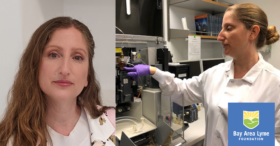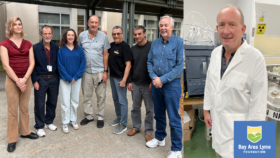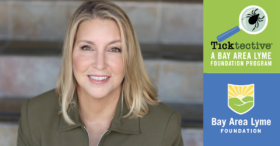By Bay Area Lyme Foundation Ticktective Podcast Transcript
In this interview, author/filmmaker, Kris Newby, explains the murky history behind the US government’s involvement with Lyme disease and continued efforts to hide how the military’s bioweapons programs caused the spread of tick-borne pathogens. She explains how alliances between pharmaceutical companies, insurance companies, university-based research teams, and the government led to inaccurate testing and denials of care, causing untold suffering to millions. Kris draws parallels between Long Covid and chronic Lyme and shines a light on how we are being dismissed, misinformed, and deliberately misled by the very institutions that should be protecting us.
 Dana Parish: I’m so excited to welcome Kris Newby. Kris is an award-winning medical science writer and a senior producer of the Lyme documentary Under Our Skin, which premiered at the Tribeca Film Festival and was a 2010 Oscar Semifinalist. Her book Bitten: The Secret History of Lyme Disease and Biological Weapons has won three international book awards. I loved your book so much for journalism and narrative nonfiction. Kris has two engineering degrees and has worked as a science technology writer for Stanford Medical School, Apple Computer, and other Silicon Valley companies. Welcome Kris!
Dana Parish: I’m so excited to welcome Kris Newby. Kris is an award-winning medical science writer and a senior producer of the Lyme documentary Under Our Skin, which premiered at the Tribeca Film Festival and was a 2010 Oscar Semifinalist. Her book Bitten: The Secret History of Lyme Disease and Biological Weapons has won three international book awards. I loved your book so much for journalism and narrative nonfiction. Kris has two engineering degrees and has worked as a science technology writer for Stanford Medical School, Apple Computer, and other Silicon Valley companies. Welcome Kris!
Kris Newby: Thanks Dana, and thanks for having me on the podcast.
Dana Parish: I’m so excited because you are one of the greatest historians of Lyme and you were so helpful to Steve Phillips and me when we wrote our book, Chronic. We loved your book. And Under Our Skin is the film that informed my view of what was really happening with Lyme disease. You’ve been working on Lyme education for 20 years. You’ve done a film, you’ve written a great book, you’ve published articles, you’ve worked in nonprofits, and you recovered from your own tick-borne diseases. How big is the Lyme problem?
Kris Newby: Ginormous and growing. The CDC’s latest estimate is half a million new cases of Lyme disease a year, and I’m sure everyone remembers when Covid hit a half a million. It was like, “Oh no, we have a problem here.” But for some reason, Lyme disease hasn’t bubbled up as a problem. 500,000 cases a year is an average of 1,300 a day. And, obviously, that mostly happened in the summer, so it’s huge. I am often frustrated because I’ve been working in this field for 20 years and not much has gotten better. The disease—this tick-borne disease—if it’s caught early, it can be cured. But we have a test that isn’t reliable in the first month, and later on it’s no better than a coin flip. About 10-30% of the people who are treated with a recommended treatment—according to what study you read—go on to become chronically ill. And the establishment has invested very little in new treatment protocols. I did an analysis with another Bay Area Lyme person of the NIH grants for the last five years, and less than 1% of the Lyme disease NIH budget is spent on treatments.
 Sunjya Schweig, MD, founder of the California Center for Functional Medicine, discusses a new program he is developing with funding from Bay Area Lyme to provide education and awareness about Lyme disease and the risks of tick-borne infections for firefighters. Firefighters have a profile of unique occupational exposures, including tick bites, and there is a significant lack of education on this topic. This new program aims to create professional, engaging videos featuring firefighters sharing their experiences and providing information on tick bite prevention, checking for ticks, and what to do if bitten. The goal is to roll out the program in California first, targeting professional firefighter and first responder organizations and eventually expanding nationwide. The exact number of firefighters living with Lyme disease is unknown, but it is acknowledged that they have both occupational and recreational exposures. This new program is seen as a way to bring awareness and education to this population and beyond.
Sunjya Schweig, MD, founder of the California Center for Functional Medicine, discusses a new program he is developing with funding from Bay Area Lyme to provide education and awareness about Lyme disease and the risks of tick-borne infections for firefighters. Firefighters have a profile of unique occupational exposures, including tick bites, and there is a significant lack of education on this topic. This new program aims to create professional, engaging videos featuring firefighters sharing their experiences and providing information on tick bite prevention, checking for ticks, and what to do if bitten. The goal is to roll out the program in California first, targeting professional firefighter and first responder organizations and eventually expanding nationwide. The exact number of firefighters living with Lyme disease is unknown, but it is acknowledged that they have both occupational and recreational exposures. This new program is seen as a way to bring awareness and education to this population and beyond.








 Dana Parish: I am so excited today because I’m here with Dr. Todd Maderis. Thank you so much for being here today. I’m thrilled to talk to you. Let me tell you a little about Dr. Maderis. He’s the founder and medical director of
Dana Parish: I am so excited today because I’m here with Dr. Todd Maderis. Thank you so much for being here today. I’m thrilled to talk to you. Let me tell you a little about Dr. Maderis. He’s the founder and medical director of 

